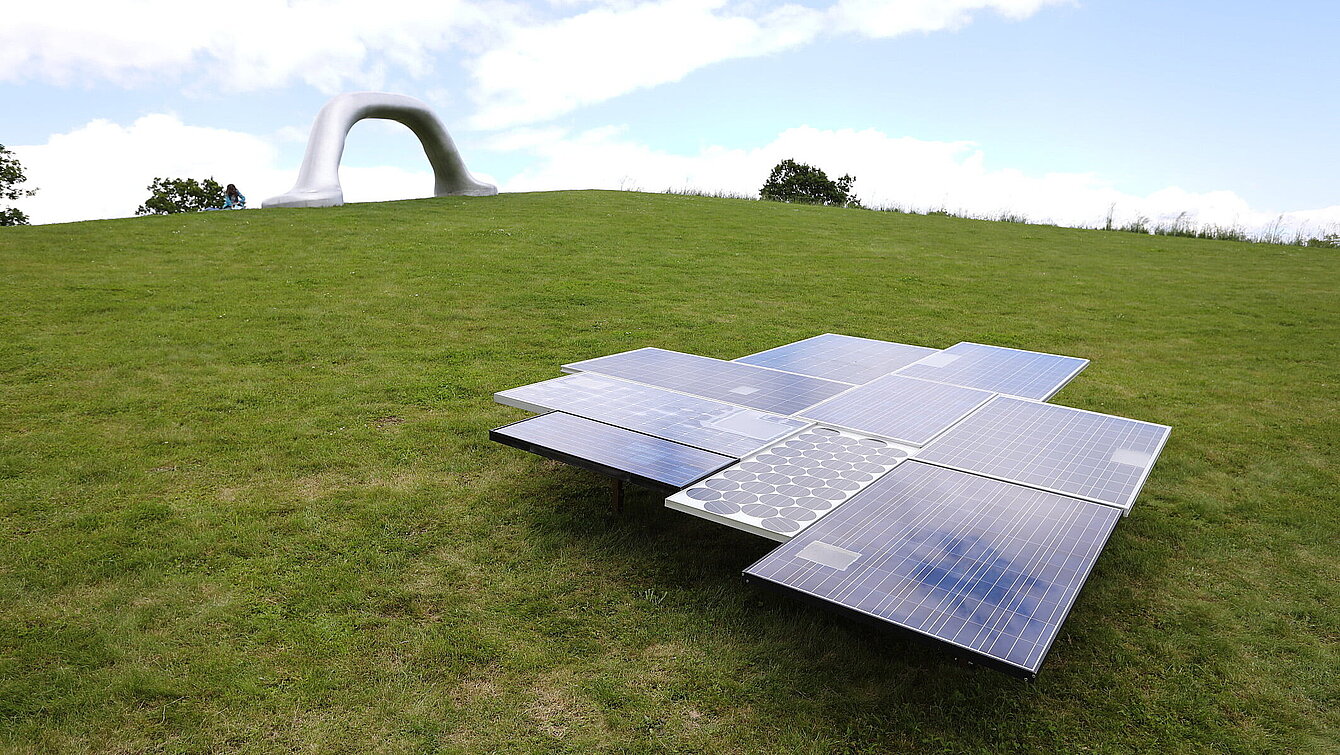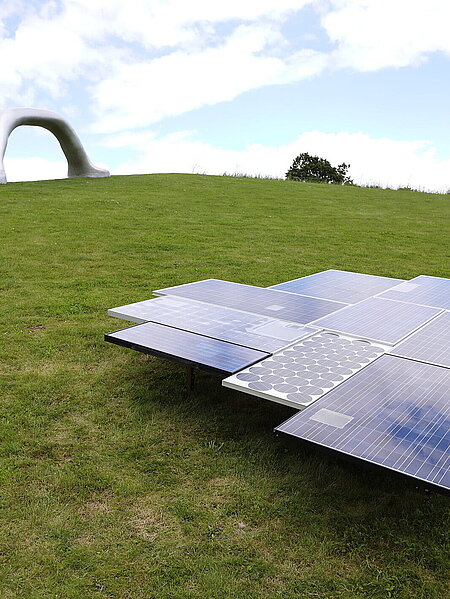Anchored on a sloping meadow surface, Judith Fegerl mounts an archaic-looking, open and at the same time slightly dystopian structure on which various panels are located. Influenced by our experience, we are reminded of roof and house constructions that usually serve as the basis for photovoltaic panels.
On the structural, approximately knee-high steel frame are nine solar panels, some of which are 20 years old, of different sizes, production and application areas from the PVRE2 research project's collection. Recycling and repairing old PV panels is the research focus of this alliance between Silicon Labs Graz, Montan University Leoben and the OFI (Austrian Research and Testing Institute) in Vienna.
The artist is not concerned with the formulation of a form, but rather with the visualization of systems and relationships, whose volatility and provisional nature are put up for debate in the gesture of a drawing thrown down rather than as a rigidly positioned statement. Fegerl shows energy sources and their technical, contextual and temporal progressions, which are understood as a fundamental achievement of technical revolutions, but at the same time are concealed as much as possible, as invisibly as possible, in order to fulfill their serving function.
Thus, the downsides of "clean energy", namely the problems of production and disposal, are addressed, the residual energy remaining in the panels that cannot escape is questioned and different forms, surfaces and formats, color and material changes are considered. In the reassembly and installation of used parts left to the artist, the theme of "Second Life" opens up, which appears optionally in the possibilities of separating precious metal and other materials or repairing them. In the knowledge that part of the Austrian Sculpture Park was once a landfill site, Judith Fegerl reflects on the attempt to keep material and resource cycles going.
The aesthetic structure of the differently shaped cells, which are round or square depending on their stage of development, is reminiscent of constructivist and minimalist works of art as well as urban planning considerations. Silicon cells break through ordered patterns and create the effect of ice flowers on the surface. In their separateness and at the same time new combination, they appear broken, but in fact they still generate electricity and are active factors. Thus they remain charged, still convey energy, seem freed from any serving function and stand for themselves.
Normally perceived as "disfigurement" on roofs, here the panels unfold as autonomous statements. Fegerl is less interested in their current state than in their inherent energy and the untapped potential that they carry within them. Questions about expiration dates, reanimation or circularity, i.e. questions about time, meet those about space, its function and availability in an artistic reformulation.
Technical-formal parameters of the rectangular format, in which round, angular, mono- and polycrystalline cells are applied and laminated onto plastic layers, as well as the arranged quantities or the color palette, encounter aesthetic considerations of repetitive pattern structures that take continuity and infinity into account and carry them within themselves.
Architectural principles are questioned as well as the theme of pattern recognition or individual panels reminiscent of woven carpets, the production of which is usually associated with the feminine. This can be seen classically in the Bauhaus structure. We know that the loom is the cradle of the computer, which in turn has male connotations. At the same time, cell structures form the basis of life and make any gender assignment appear obsolete.
In all these aspects, this work opens up and shifts many relations. Fegerl, who comes from the field of technology, takes the freedom of intuitive composition of the given, placing the cells together not systematically but playfully. The contrast and connection between technology and emotion/intuition is also illustrated by the intense blue tones of the panels.
With the title sunset, Fegerl deliberately refers to the complexity of the technical term "server sunset". The term server - standing for service and permanent functioning - is coupled here with the romantic topos of the sunset. This euphemistic term is used in the economy when production has reached the end of its ability and usefulness and is withdrawn from circulation due to uselessness. The sun shines on each of the panels, it is the basic condition for their use, to which the "sunset clauses", a predetermined expiry date, is inscribed.
They are logical materials with signs of wear, evidence of former energy sources, stripped of their function, which Judith Fegerl draws on for her work and thematizes as new potential raw material resources. "Revers", the anagram of "server", is an important term for her, which keeps the reversible relationship between art and viewer in tension.
Fegerl is thus concerned with what lies beneath the visible, the deep layers of architectures, spaces, surfaces and landscapes. In doing so, she interrupts constructed circuits of thought and opens up new perspectives and possibilities of perception. Functionalities are questioned, new identity structures are made possible. She addresses apparent discrepancies such as technology and the body, mechanical construction and consciousness, the organic and the inorganic, in order to reveal, contrast, connect or rethink them.
You can find out more about the background to the material here.




















